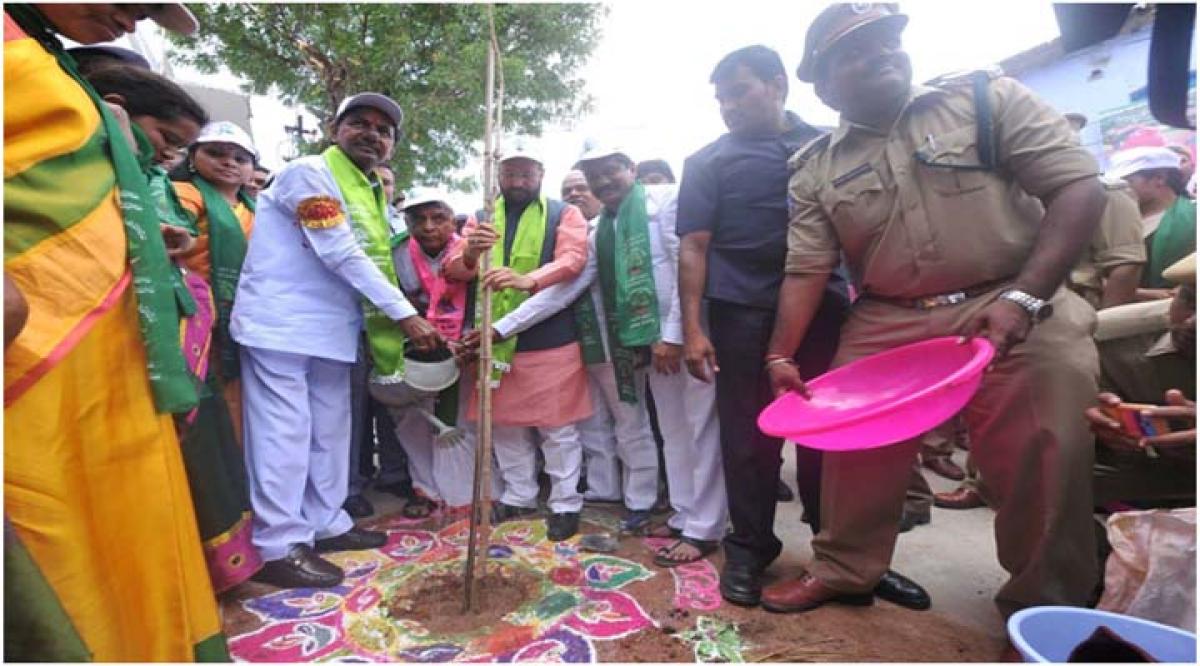Live
- Time to get rid of Sattavad and Parivarvad politics
- Extend neither spl nor ill treatment
- Must-Watch OTT Originals in 2024: The Year’s Best Shows and Movies
- 40 Indian startups secure over $787 mn in a week
- India now formidable force on chess board
- Raghavendra Mutt pontiff visits Tirumala
- Whistleblower of OpenAI found dead in US apartment
- Trump’s US-first policy & India’s strategic latitude
- Chandrababu pays tribute to Potti Sriramulu and Sardar Vallabhbhai Patel
- India may miss TB elimination target
Just In

National Forest Policy of India envisages a minimum of 33% of the total geographical area under forest / tree cover to maintain environmental stability and ecological balance; that are vital for sustenance of all life forms, human, animal and plants.
Telangana Ku Haritha Haram
National Forest Policy of India envisages a minimum of 33% of the total geographical area under forest / tree cover to maintain environmental stability and ecological balance; that are vital for sustenance of all life forms, human, animal and plants.
Telangana Ku Haritha Haram, a flagship programme of the Telangana Government envisages increasing the present 24% tree cover in the State to 33% of the total geographical area of the State. The thrust areas to achieve the above are two-fold; one, initiatives in notified forest areas, and the other, initiatives in areas outside the notified forest areas. The first objective is sought to be achieved by a multi-pronged approach of rejuvenating degraded forests, ensuring more effective protection of forests against smuggling, encroachment, fire, grazing and intensive soil and moisture conservation measures following the watershed approach.
Major fillip is sought to be given to Social Forestry for achieving the second objective. In the areas outside the notified forest, massive planting activities will be taken up in areas such as; road-side avenues, river and canal bank, barren hill, tank bunds and foreshore areas, institutional premises religious places, housing colonies, community lands, municipalities, industrial parks, etc.religious places, housing colonies, community lands, municipalities, industrial parks, etc.
230 Crore seedlings are proposed to be planted in the State during the next three years. Out of this, 130 crores seedlings are proposed to be planted outside the notified forest areas (10 crores within HMDA limits, and the remaining 120 Crores in rest of the State). It is also proposed to plant, and rejuvenate the viable rootstock to achieve 100 crore plants inside the forest areas by way of intensive protection of the forests.
During 2015-16, planting drive in the entire State will be taken up in 2nd week of July. People from all walks of life, Government agencies, officers, prominent citizens, and public representatives will participate in the programme.
The field functionaries of various line Departments have undertaken identification of sites for planting and prepared village Action Plans. The Village Action Plans will be consolidated at a Mandal level and finally at the District level to form District Action Plan. At State level, two committees; the State Level Coordination and Monitoring Committee, and the State Level Steering Committee oversee the progress of the TKHH programme.
Silviculture system of Management: Management of the State Forests is carried out by the Forest Department with an objective of progressive and sustained yield. The Departmental schemes are oriented one and to increase yield potentiality per hectare of the Forest Resources in the state, so as to meet the demands of the multiplying population and wood based industries.
The entire forest area is brought out under the sanctioned working plans and it is managed on the scientific lines. As per the guidelines issued by the Government of India, extraction of natural forests is completely stopped. Most of the Degraded Forest Area is being regenerated through Community Forest Management according to the Micro Plan prescriptions.
The Micro plans are prepared in consultation with the members of Vana Samrakshana Samithis. The working plans are prepared for ten years. The entire (6) Circles, (22) Divisions are included and (1) Division Nagarjunasagar is not included in the working plans. Out of the (22) divisions except Jannaram Division Working Plan, (21) Division working plans are approved by Govt. of India.
Under State Plan Scheme, the Silvicultural research was being implemented through Regional Offices. To develop species, specific areas introduced high yielding varieties in the planting programmes. There is a significant improvement in natural forests under afforestation of the large tracts of degraded forests lands by involving VSS under Community Forest Management Programme (CFMP).
A scheme was launched to conduct experiments and standardize the improved nursery techniques, vegetative propagation, natural forest management etc. Further, the researchers helped in conducting trials on improved nursery technology, standardize of potting medium, development and maintenance of demonstration plots etc., on a variety of indigenous timber species.

© 2024 Hyderabad Media House Limited/The Hans India. All rights reserved. Powered by hocalwire.com







